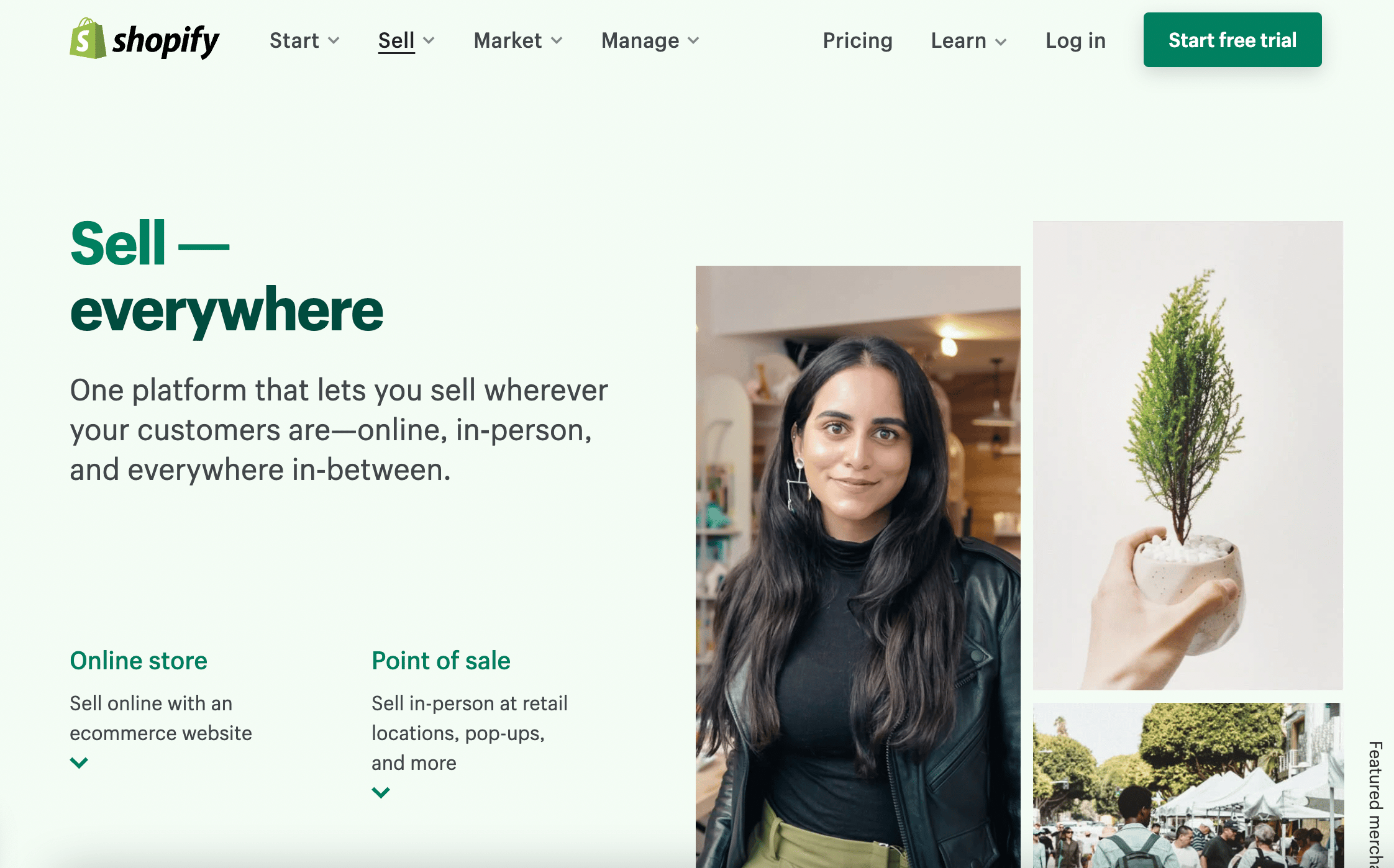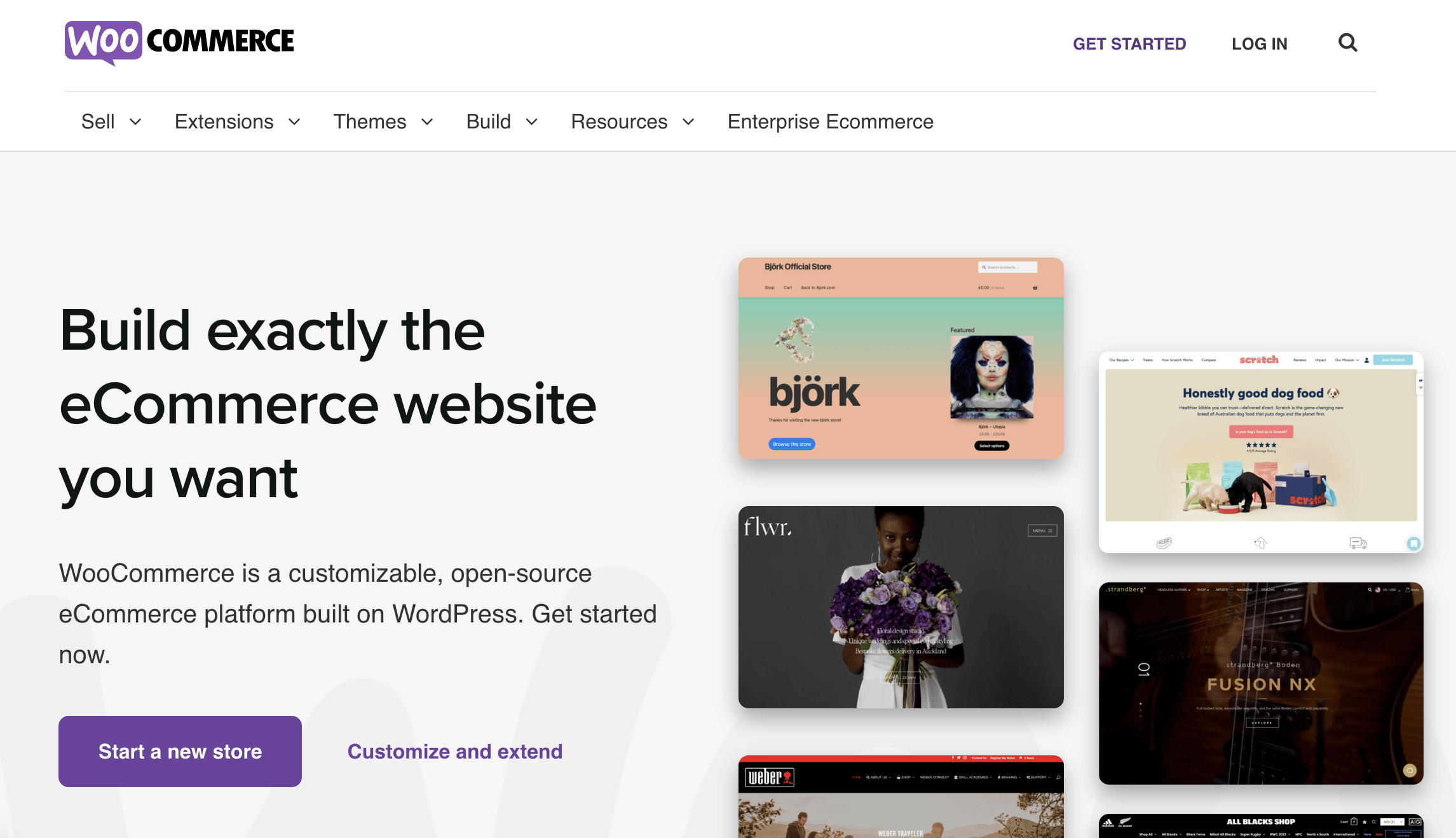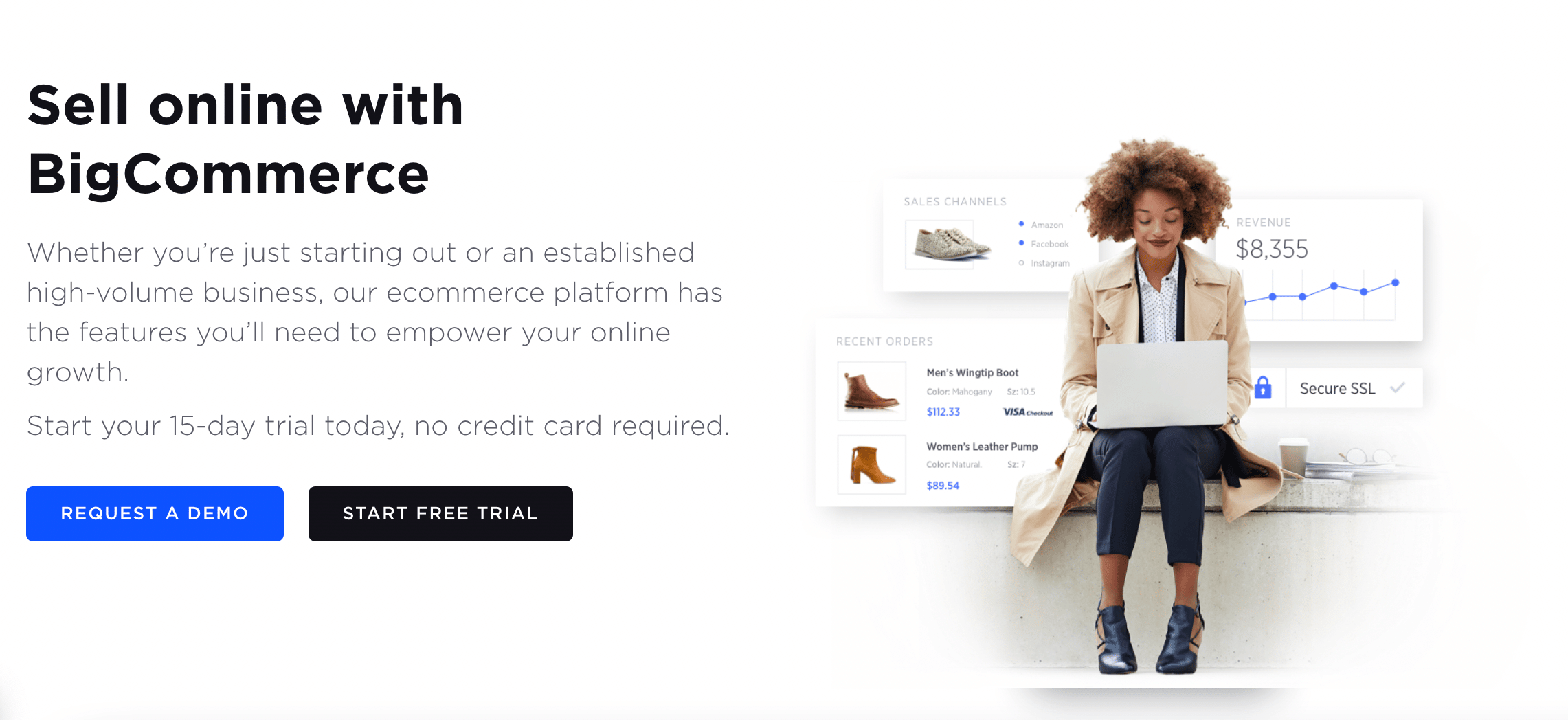The 4 Best Ecommerce Platforms for Selling in 2023
What’s the best ecommerce platform to use for 2023?
Like many questions in life, the answer depends on who you ask. But don’t worry, because we did the research for you! We’ve come up with our list of the top four ecommerce platforms for businesses to use in 2023.
We’ll walk you through the pros and cons of each platform and how to choose one that works for you. There’s a handy, frequently asked questions guide at the end of this piece. You’ll walk away knowing which is the best platform to get your online store up and running.
So, whether you’re just starting out or you’re looking to switch platforms, we can help. Read on to find out which ecommerce platform is best for you.
Bonus: Learn how to sell more products on social media with our free Social Commerce 101 guide. Delight your customers and improve conversion rates.
Best ecommerce platforms for selling in 2023
With so many ecommerce platforms on the market, choosing the right one can seem daunting. The entire success of your ecommerce store could depend on it. But have no fear! In no particular order, here are our top four picks for 2023.
1. Squarespace
Squarespace allows you to create an online store with everything you need in minutes. Their selection of ecommerce templates is a helpful tool for beginners.

What it’s best for: Beautiful ecommerce store templates and drag and drop design.
Starting price: Free 14-day trial with new sites, then Squarespace’s Business package starts at $23/month. Squarespace’s Personal package at $16/month does not include ecommerce integration.
Pros: Access to marketing, inventory, social selling, SEO, and analytics features. Sleek templates. Drag and drop website builder.
Cons: Fewer features compared to competitors. 3% transaction rates (at starting Business package).
2. Shopify
Shopify is a powerful, user friendly ecommerce platform. It offers a solid foundation to get you started selling online ASAP.
Source: Shopify
What it’s best for: Ecommerce-specific businesses of any size, creators, and businesses selling directly on Instagram or TikTok.
Starting price: A free 14-day trial or you can get Basic Shopify at $29/month
Pros: Shopify can take care of nearly all ecommerce-related tasks. They offer support with everything from marketing tools and payments, to secure checkout and shipping. Selling on Shopify is easy. Shopify integrates with most other platforms, websites, and online marketplaces. It is one of the best multi-channel ecommerce platforms.
Bonus tip: If you use Shopify to sell your products, you can get a chatbot integration from Heyday by Hootsuite. A chatbot can help you save time on customer service and sell more products by answering FAQs, providing customer support, recommending products, taking care of inventory management and offering in-store appointment booking.
Cons: Add-ons can add up in cost. Limited blog post features without app add-ons. Checkout is not customizable.
3. WooCommerce
WooCommerce is a WordPress plugin that can transform your WordPress site into an ecommerce store. It’s the best free ecommerce platform.
Source: WooCommerce
What it’s best for: Building and managing a customizable, versatile online store.
Starting price: Free! But, there are hidden costs you will want to be aware of.
Pros: All of WordPress’s powerful plugins and integrations are available to you. Flexibility and ease of use. It’s free.
Cons: Virtually zero customer service. Additional costs like domain hosting and plugins.
4. BigCommerce
BigCommerce is an ecommerce SaaS provider that services online retailers.
Source: BigCommerce
What it’s best for: Ecommerce stores with large inventories.
Starting price: Free 15-day trial, then $29.95/month.
Pros: Unlimited amount of products. There are no transaction fees. It has a wide array of features. Sleek themes, though many cost money.
Cons: Sometimes poor loading speeds. If your store has a higher sales volume, you’ll pay more. No 1-Click Selling features.
Bonus: Learn how to sell more products on social media with our free Social Commerce 101 guide. Delight your customers and improve conversion rates.
Get the guide now!How to choose an ecommerce platform that works for you
There are a lot of factors to consider when choosing an ecommerce platform. The best ecommerce platforms offer what you need to run your business. To choose the best platform for you, start with your business’s specific needs and objectives.
Do you sell on Etsy and need to connect to your other store? Do you want to have a business blog on your website? Do you want to have a Shopify chatbot help with customer inquiries?
Once you’ve determined your must-have features, you can start narrowing down your options. Here are a few thought-starters that will help you decide which ecommerce features you need from a platform.
Do you have a brick-and-mortar location?
If you have a brick-and-mortar location, you’ll want to make sure your ecommerce store is cohesively branded and gives the consumer an experience consistent with your physical store. This may mean you need a more customizable website to create an optimal customer journey.
Consider the size of your inventory
If you’re planning on selling a large number of products, then it’s important to choose a platform that can accommodate your inventory. With a large inventory, you’ll need a platform that can handle complex product categorization and stock management.
Are you going to use dropshipping?
Dropshipping is where you receive customer orders but don’t keep your own stock on hand. You outsource order fulfillment and shipping to a third party. If you decide to dropship, you’ll want to choose a platform that can handle dropshipping, like Shopify.
What kind of products or services are you offering?
If you’re selling digital products, then you’ll need a platform that can support file downloads. If you’re selling physical products, then you’ll need a platform that can integrate with a shipping service. If you’re selling services that require appointments to be made, you’ll want a platform that can integrate scheduling.
You will also want to consider the amount of products you’ll be offering. If the number is large, you may want to consider an ecommerce platform and web hosting that can handle it, like BigCommerce. If you have a smaller offering, then you will be absolutely fine with a platform like Shopify or Squarespace.
Custom site design and features
You’ll also need to consider how much control you want over the look and feel of your store. If you want complete control, then you’ll need a platform that offers a lot of customization options.
If you don’t want to build it yourself, site builders are available for an additional fee.
Source: Minna
Do your profits depend on being found on SERPs?
Then you may want to choose a platform that has robust SEO features. With WooCommerce, for example, you can download SEO plugins like YOAST to improve your SEO game. This and other optimization plugins make it one of the best ecommerce platforms for SEO. BigCommerce is also a popular platform for its SEO capabilities.
What is your budget?
Another factor to consider is price. Most platforms have tiered monthly pricing; often, the higher your monthly price, the lower your transactional fees. Be sure to calculate these before you commit to a plan. Some platforms are free but come with other fees, like domain costs and the price of add-ons or plugins. Compare pricing plans to find the best value for your business.
Ecommerce platforms FAQs
Do you still have questions? Well, we’ve got you covered. Here are some popular, frequently asked questions about ecommerce platforms.
What is the largest ecommerce platform?
Amazon is the largest global ecommerce platform in terms of traffic. WooCommerce, however, has the largest market share of ecommerce software platforms.
According to Statista, WooCommerce is the top pick worldwide ecommerce software platform, with a market share of 37%. Squarespace Online Stores and Woo Themes came in second and third, with shares of 15% and 14%.
What is the best ecommerce platform for startups?
WooCommerce, Shopify, and Squarespace are all great ecommerce platforms for startups.
The question you should be asking isn’t which ecommerce platform is best for startups. Rather, ask yourself, which ecommerce platform is best for my startup? If you sell online courses, then you’d probably choose a different platform than a startup that sells vintage clothing.
What are the most popular ecommerce platforms?
The most popular ecommerce platforms are WooCommerce and Squarespace. They hold the most market share. But that’s a pretty wide generalization. While these platforms hold the most market share, it could be worth your time to find out which ecommerce platform is most popular among your peers.
We would recommend doing some research beforehand. If you know of others in your field who have an ecommerce store, ask them whether they like their platform or not. Or, search on popular reviewing sites with your industry in mind. Reddit will often net you some very honest results about selling products online.
What is the best ecommerce platform for small business?
The best ecommerce platform for small business depends on what kind of small business you own. That being said, many small business owners gravitate towards ecommerce platforms that are easy to use. Typically, these platforms are hosted solutions instead of open-source.
Hosted solutions are ones like Squarespace and Shopify. Typically, they require less up-front work than open-source solutions like WooCommerce. That being said, WooCommerce is the best open source ecommerce platform, in our humble opinion. But, each ecommerce solution has its own advantages for small businesses.
Squarespace’s ecommerce templates are a quick way for small businesses to get up and running online. Shopify’s ability to integrate easily with other platforms makes it a popular choice. WooCommerce’s SEO capabilities make it attractive for small businesses competing for exposure on SERPs.
What is the best ecommerce platform for Instagram?
Shopify is the best ecommerce platform for selling on Instagram. Integration with apps from the Shopify app store is quick and easy. You can find apps that help with shipping, abandoned cart recovery, customer support and more.
Any ecommerce platform worth its salt will let you link to your social media accounts. But Shopify stands out by allowing customers to easily engage in social shopping directly on Instagram (and TikTok, for that matter!) using apps like Heyday, a conversational ai chatbot.
Here’s more on how to make the most of your Instagram ecommerce strategy.
Engage with ecommerce shoppersand turn customer conversations into sales with Heyday, our dedicated conversational AI chatbot for ecommerce and social commerce retailers. Deliver 5-star customer experiences — at scale.
Turn customer service conversations into sales with Heyday. Improve response times and sell more products. See it in action.
Free DemoThe post The 4 Best Ecommerce Platforms for Selling in 2023 appeared first on Social Media Marketing & Management Dashboard.
Categories
- 60% of the time… (1)
- A/B Testing (2)
- Ad placements (3)
- adops (4)
- adops vs sales (5)
- AdParlor 101 (43)
- adx (1)
- algorithm (1)
- Analysis (9)
- Apple (1)
- Audience (1)
- Augmented Reality (1)
- authenticity (1)
- Automation (1)
- Back to School (1)
- best practices (2)
- brand voice (1)
- branding (1)
- Build a Blog Community (12)
- Case Study (3)
- celebrate women (1)
- certification (1)
- Collections (1)
- Community (1)
- Conference News (1)
- conferences (1)
- content (1)
- content curation (1)
- content marketing (1)
- contests (1)
- Conversion Lift Test (1)
- Conversion testing (1)
- cost control (2)
- Creative (6)
- crisis (1)
- Curation (1)
- Custom Audience Targeting (4)
- Digital Advertising (2)
- Digital Marketing (6)
- DPA (1)
- Dynamic Ad Creative (1)
- dynamic product ads (1)
- E-Commerce (1)
- eCommerce (2)
- Ecosystem (1)
- email marketing (3)
- employee advocacy program (1)
- employee advocates (1)
- engineers (1)
- event marketing (1)
- event marketing strategy (1)
- events (1)
- Experiments (21)
- F8 (2)
- Facebook (64)
- Facebook Ad Split Testing (1)
- facebook ads (18)
- Facebook Ads How To (1)
- Facebook Advertising (30)
- Facebook Audience Network (1)
- Facebook Creative Platform Partners (1)
- facebook marketing (1)
- Facebook Marketing Partners (2)
- Facebook Optimizations (1)
- Facebook Posts (1)
- facebook stories (1)
- Facebook Updates (2)
- Facebook Video Ads (1)
- Facebook Watch (1)
- fbf (11)
- first impression takeover (5)
- fito (5)
- Fluent (1)
- Get Started With Wix Blog (1)
- Google (9)
- Google Ad Products (5)
- Google Analytics (1)
- Guest Post (1)
- Guides (32)
- Halloween (1)
- holiday marketing (1)
- Holiday Season Advertising (7)
- Holiday Shopping Season (4)
- Holiday Video Ads (1)
- holidays (4)
- Hootsuite How-To (3)
- Hootsuite Life (1)
- how to (5)
- How to get Instagram followers (1)
- How to get more Instagram followers (1)
- i don't understand a single thing he is or has been saying (1)
- if you need any proof that we're all just making it up (2)
- Incrementality (1)
- influencer marketing (1)
- Infographic (1)
- Instagram (39)
- Instagram Ads (11)
- Instagram advertising (8)
- Instagram best practices (1)
- Instagram followers (1)
- Instagram Partner (1)
- Instagram Stories (2)
- Instagram tips (1)
- Instagram Video Ads (2)
- invite (1)
- Landing Page (1)
- link shorteners (1)
- LinkedIn (22)
- LinkedIn Ads (2)
- LinkedIn Advertising (2)
- LinkedIn Stats (1)
- LinkedIn Targeting (5)
- Linkedin Usage (1)
- List (1)
- listening (2)
- Lists (3)
- Livestreaming (1)
- look no further than the new yorker store (2)
- lunch (1)
- Mac (1)
- macOS (1)
- Marketing to Millennials (2)
- mental health (1)
- metaverse (1)
- Mobile App Marketing (3)
- Monetizing Pinterest (2)
- Monetizing Social Media (2)
- Monthly Updates (10)
- Mothers Day (1)
- movies for social media managers (1)
- new releases (11)
- News (72)
- News & Events (13)
- no one knows what they're doing (2)
- OnlineShopping (2)
- or ari paparo (1)
- owly shortener (1)
- Paid Media (2)
- People-Based Marketing (3)
- performance marketing (5)
- Pinterest (34)
- Pinterest Ads (11)
- Pinterest Advertising (8)
- Pinterest how to (1)
- Pinterest Tag helper (5)
- Pinterest Targeting (6)
- platform health (1)
- Platform Updates (8)
- Press Release (2)
- product catalog (1)
- Productivity (10)
- Programmatic (3)
- quick work (1)
- Reddit (3)
- Reporting (1)
- Resources (34)
- ROI (1)
- rules (1)
- Seamless shopping (1)
- share of voice (1)
- Shoppable ads (4)
- Skills (28)
- SMB (1)
- SnapChat (28)
- SnapChat Ads (8)
- SnapChat Advertising (5)
- Social (169)
- social ads (1)
- Social Advertising (14)
- social customer service (1)
- Social Fresh Tips (1)
- Social Media (5)
- social media automation (1)
- social media content calendar (1)
- social media for events (1)
- social media management (2)
- Social Media Marketing (49)
- social media monitoring (1)
- Social Media News (4)
- social media statistics (1)
- social media tracking in google analytics (1)
- social media tutorial (2)
- Social Toolkit Podcast (1)
- Social Video (5)
- stories (1)
- Strategy (605)
- terms (1)
- Testing (2)
- there are times ive found myself talking to ari and even though none of the words he is using are new to me (1)
- they've done studies (1)
- this is also true of anytime i have to talk to developers (1)
- tiktok (8)
- tools (1)
- Topics & Trends (3)
- Trend (12)
- Twitter (15)
- Twitter Ads (5)
- Twitter Advertising (4)
- Uncategorised (9)
- Uncategorized (13)
- url shortener (1)
- url shorteners (1)
- vendor (2)
- video (10)
- Video Ads (7)
- Video Advertising (8)
- virtual conference (1)
- we're all just throwing mountains of shit at the wall and hoping the parts that stick don't smell too bad (2)
- web3 (1)
- where you can buy a baby onesie of a dog asking god for his testicles on it (2)
- yes i understand VAST and VPAID (1)
- yes that's the extent of the things i understand (1)
- YouTube (13)
- YouTube Ads (4)
- YouTube Advertising (9)
- YouTube Video Advertising (5)




